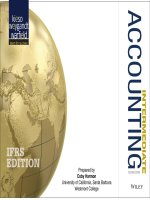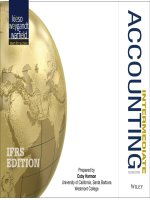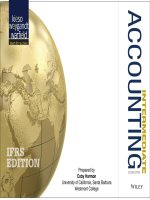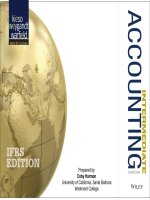Lecture Intermediate accounting (IFRS 2nd edition): Chapter 21 - Kieso, Weygandt, Warfield
Bạn đang xem bản rút gọn của tài liệu. Xem và tải ngay bản đầy đủ của tài liệu tại đây (4.91 MB, 108 trang )
21-1
PREVIEW OF CHAPTER
21
Intermediate Accounting
IFRS 2nd Edition
Kieso, Weygandt, and Warfield
21-2
21
Accounting for Leases
LEARNING OBJECTIVES
After studying this chapter, you should be able to:
1. Explain the nature, economic
substance, and advantages of lease
transactions.
2. Describe the accounting criteria and
procedures for capitalizing leases by the
lessee.
3. Contrast the operating and capitalization
methods of recording leases.
4. Explain the advantages and economics
of leasing to lessors and identify the
classifications of leases for the lessor.
21-3
5. Describe the lessor’s accounting for
directfinancing leases.
6. Identify special features of lease
arrangements that cause unique
accounting problems.
7. Describe the effect of residual values,
guaranteed and unguaranteed, on lease
accounting.
8. Describe the lessor’s accounting for sales
type leases.
9. List the disclosure requirements for
leases.
THE LEASING ENVIRONMENT
Who Are the Players?
A lease is a contractual agreement between a lessor and a
lessee, that gives the lessee the right to use specific
property, owned by the lessor, for a specified period of time.
Largest group of leased equipment involves:
uInformation technology equipment
uTransportation (trucks, aircraft, rail)
uConstruction
uAgriculture
21-4
LO 1
ILLUSTRATION 212
What Do Companies
Lease?
21-5
THE LEASING ENVIRONMENT
Who Are the Players?
Banks
Independents
► Credit Suisse
► CNH Capital
(CHE)
(NLD) (for CNH
Global),
► Chase (USA)
► BMW Financial
► Barclays (GBR)
► Deutsche Bank
(DEU)
Captive
Leasing
Companies
30%
Services
(DEU) (for
BMW)
► IBM Global
Financing
(USA) (for IBM)
44%
21-6
Market Share
26%
LO 1
THE LEASING ENVIRONMENT
Advantages of Leasing
1.
100% financing at fixed rates.
2.
Protection against obsolescence.
3.
Flexibility.
4.
Less costly financing.
5.
Tax advantages.
6.
21-7
OFFBALANCESHEET FINANCING
Offbalancesheet
financing.
LO 1
THE LEASING ENVIRONMENT
Conceptual Nature of a Lease
Capitalize a lease that transfers substantially all of the
benefits and risks of property ownership, provided the
lease is noncancelable.
Leases that do not transfer
substantially all the benefits
and risks of
ownership are operating leases.
21-8
LO 1
21
Accounting for Leases
LEARNING OBJECTIVES
After studying this chapter, you should be able to:
1. Explain the nature, economic substance,
and advantages of lease transactions.
5. Describe the lessor’s accounting for
directfinancing leases.
2. Describe the accounting criteria and
procedures for capitalizing leases by
the lessee.
6. Identify special features of lease
arrangements that cause unique
accounting problems.
3. Contrast the operating and capitalization
methods of recording leases.
7. Describe the effect of residual values,
guaranteed and unguaranteed, on lease
accounting.
4. Explain the advantages and economics
of leasing to lessors and identify the
classifications of leases for the lessor.
21-9
8. Describe the lessor’s accounting for sales
type leases.
9. List the disclosure requirements for
leases.
ACCOUNTING BY THE LESSEE
If the lessee capitalizes a lease, the lessee records an asset
and a liability generally equal to the present value of the rental
payments.
uRecords depreciation on the leased asset.
uTreats the lease payments as consisting of interest and
principal.
ILLUSTRATION 212
Journal Entries for Capitalized Lease
21-10
LO 2
ACCOUNTING BY THE LESSEE
For a finance lease, the IASB has identified four criteria.
1.
Lease transfers ownership of the property to the lessee.
2.
Lease contains a bargainpurchase option.
3.
4.
21-11
Lease term is for major part of the economic life of the
asset.
Present value of the minimum
lease payments amounts to
substantially all of the fair
value of the leased asset.
One or more
must be met
for finance
lease
accounting.
LO 2
ACCOUNTING BY THE LESSEE
Lease Agreement
Leases that DO NOT meet any of
the four criteria are accounted for
as operating leases.
ILLUSTRATION 214
Diagram of Lessee’s Criteria for Lease Classification
21-12
LO 2
ACCOUNTING BY THE LESSEE
Capitalization Criteria
Transfer of Ownership Test
uIf the lease transfers ownership of the asset to the lessee,
it is a finance lease.
BargainPurchase Option Test
uAt the inception of the lease, the difference between the
option price and the expected fair market value must be
large enough to make exercise of the option reasonably
assured.
21-13
LO 2
ACCOUNTING BY THE LESSEE
Capitalization Criteria
Economic Life Test
uLease term is generally considered to be the fixed, non
cancelable term of the lease.
uBargainrenewal option can extend this period.
uAt the inception of the lease, the difference between the
renewal rental and the expected fair rental must be
great enough to make exercise of the option to
renew reasonably assured.
21-14
LO 2
ACCOUNTING BY THE LESSEE
Illustration: Carrefour (FRA) leases Lenovo (CHN) PCs
for two years at a rental of €100 per month per computer
and subsequently can lease them for €10 per month per
computer for another two years. The lease clearly offers a
bargainrenewal option; the lease term is considered to be
four years.
21-15
LO 2
ACCOUNTING BY THE LESSEE
Capitalization Criteria
Recovery of Investment Test
Minimum Lease Payments:
l Minimum rental payments
l Guaranteed residual value
l Penalty for failure to renew or extend the lease
l Bargainpurchase option
Executory Costs:
l Insurance
l Maintenance
l Taxes
21-16
Exclude from PV of
Minimum Lease
Payment
Calculation
LO 2
ACCOUNTING BY THE LESSEE
Capitalization Criteria
Recovery of Investment Test
Discount Rate
21-17
u
Lessee computes the present value of the minimum lease
payments using the implicit interest rate.
u
In the event it is impracticable to determine the implicit
rate, the lessee should use its incremental borrowing
rate.
LO 2
ACCOUNTING BY THE LESSEE
Asset and Liability Accounted for Differently
Asset and Liability Recorded at the lower of:
1.
present value of the minimum lease payments
(excluding executory costs) or
2.
fair market value of the leased asset at the inception
of the lease.
21-18
LO 2
ACCOUNTING BY THE LESSEE
Asset and Liability Accounted for Differently
Depreciation Period
uIf lease transfers ownership, depreciate asset over
the economic life of the asset.
uIf lease does not transfer ownership, depreciate
over the term of the lease.
21-19
LO 2
ACCOUNTING BY THE LESSEE
Asset and Liability Accounted for Differently
EffectiveInterest Method
u
Used to allocate each lease payment between principal
and interest.
Depreciation Concept
u
Depreciation and the discharge of the obligation are
independent accounting processes.
21-20
LO 2
ACCOUNTING BY THE LESSEE
21-21
Illustration: CNH Capital (NLD) (a subsidiary of CNH Global) and Ivanhoe Mines
Ltd. (CAN) sign a lease agreement dated January 1, 2015, that calls for CNH to
lease a frontend loader to Ivanhoe beginning January 1, 2015. The terms and
provisions of the lease agreement and other pertinent data are as follows.
•
The term of the lease is five years. The lease agreement is noncancelable,
requiring equal rental payments of $25,981.62 at the beginning of each year
(annuitydue basis).
•
The loader has a fair value at the inception of the lease of $100,000, an
estimated economic life of five years, and no residual value.
•
Ivanhoe pays all of the executory costs directly to third parties except for the
property taxes of $2,000 per year, which is included as part of its annual
payments to CNH.
•
The lease contains no renewal options. The loader reverts to CNH at the
termination of the lease.
•
Ivanhoe’s incremental borrowing rate is 11 percent per year.
•
Ivanhoe depreciates similar equipment that it owns on a straightline basis.
•
CNH sets the annual rental to earn a rate of return on its investment of 10
LO 2
percent per year; Ivanhoe knows this fact.
ACCOUNTING BY THE LESSEE
What type of lease is this? Explain.
Capitalization Criteria:
1. Transfer of ownership
2. Bargain purchase option
3. Lease term for major part
of economic life of
leased property
4. Present value of
minimum lease payments
substantially all of FMV of
property
21-22
Finance Lease, #3
NO
NO
Lease term = 5 yrs.
Economic life = 5 yrs.
YES
PV = $100,000
FMV = $100,000.
YES
LO 2
ACCOUNTING BY THE LESSEE
Computation of Capitalized Lease Payments
Payment
$ 25,981.62
Property taxes (executory cost)
2,000.00
Minimum lease payment
23,981.62
Present value factor (i=10%,n=5)
x 4.16986 *
PV of minimum lease payments
$100.000.00
Ivanhoe uses CNH’s implicit interest rate of 10 percent instead of its
incremental borrowing rate of 11 percent because (1) it is lower and (2) it
knows about it.
* Present value of an annuity due of 1 for 5 periods at 10% (Table 65)
21-23
LO 2
ACCOUNTING BY THE LESSEE
Ivanhoe records the finance lease on its books on January 1, 2015,
as:
Leased Equipment
100,000.00
Lease Liability
100,000.00
Ivanhoe records the first lease payment on January 1, 2015, as
follows.
Property Tax Expense
Lease Liability
2,000.00
23,981.62
Cash
21-24
25,981.62
LO 2
ACCOUNTING BY THE LESSEE
21-25
ILLUSTRATION 21-6
Lease Amortization
Schedule for Lessee—
Annuity-Due Basis
LO 2









